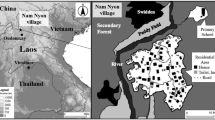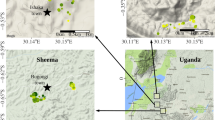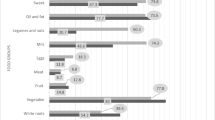Abstract
In this article data on household food consumption is used to further understanding of subsistence strategies in three Caboclo populations on Marajó Island, Amazonia, Brazil. Data were collected using participant observation and 24-hour food recalls in 16 households for 7 consecutive days during the rainy (March) and dry (July) seasons. Marajó-Açu households (n = 6) had the highest levels of energy and protein intake relative to recommendations. This was probably related to their successful integration into the prosperous acai (a palm fruit) market of the riverine area. Praia Grande households (n = 6) had the lowest values for energy intake (rainy season), which supports the authors' ethnographic observations of some instability in the subsistence system of this population. Paricatuba households (n = 4) exhibited intermediate values of energy and protein intakes, but less seasonal variation in consumption than the other two populations. Despite the differences observed, food consumption does not appear to be a major limitation for any of the three populations. The data support recent hypotheses concerning the concomitant and multiple use of várzea (floodplain) and terra firme (upland) environments by the Caboclos and integration into the local market economy as the central strategies in dealing with the so-called socioenvironmental constraints of the Amazonian floodplain.
Similar content being viewed by others
EFERENCES
Anderson,A., and Ioris, E. (1992). The logic of extraction:Resource management and resource generation by extractive producers in the estuary. In Redford, K. H., and Padoch, C. (eds.), Conservation of Neo tropical Forests.Columbia University Press, New York, pp. 158-174.
Brondízio, E. S. (1996). Forest Farmers: Human and Landscape Ecology of Caboclo Populations in the Amazon Estuary. Doctoral dissertation. School of Public and Environmental Affairs, Indiana University, Bloomington.
Brondízio, E. S., Moran, E., Mausel, P., and Wou, Y. (1994). Land use change in the Amazon estuary: Patterns of Caboclo settlement and landscape management. Human Ecology 22(3): 249-278.
Brondízio, E. S., and Neves, W. A. (1996). Populações Caboclas do estuário do Amazonas: A percepcção do ambiente natural. In Pavan, C. (ed.), Uma Estratégia Latino American a para a Amazônia. Unesp/Memorial, São Paulo, vol. 1, 167-182.
Brondízio, E., and Siqueira, A. (1997). From extractivists to forest farmers: Changing concepts of Caboclo agroforestry in the Amazon estuary. Research in Economic Anthropology 18: 233-279.
Brown, K. N. (1984). Measurement of dietary intake. In Mosley, W. H., and Chen, L. C. (eds.), Population and Developement Review. The Population Council, New York, pp. 69-91.
Chibnik, M. (1994). Risky Rivers: The Economics and Politics of Floodplain Farming in Amazonia. The University of Arizona Press, Tucson and London.
Cleary, D. (1993). After the frontier: Problems with political economy in the modern Brazilian Amazon. Journal of Latin American Studies 25(2): 331-349.
Denevan, W.M. (1996). A bluff model of riverine settlement in prehistoric Amazonia. Annual Review of the Association of American Geographers 86(4): 654-651.
Dufour, D.L. (1988).The composition of some foods used in northwest Amazonia. In terciência, 13(2): 83-86.
Dufour, D. L., and Teufel, N. I. (1995). Minimum data sets for the description of diet and measurement of food intake and nutritional status. In Moran, E. F. (ed.), The Comparative Analysis of Human Societies: Toward Common Standards for Data Collection and Reporting. Lynne Rienner Publishers, Boulder, CO.
FAO/WHO /UNU. (1985). Energy and Protein Requirenments. World Health Organization, Geneva.
Franco, G. (1987). Tabela de Composição Químicados Alimentos. Livraria Atheneu, Rio de Janeiro.
Galvão, E. (1955). Santo s e Visagens. Editora Nacional, São Paulo.
Gibson, R. S. (1990). Principles of Nutritional Assessment.Oxford University Press, New York /Oxford.
Giugliano, R., Giugliano, L. G., and Shrimpton, R. (1981). Estudos nutricinais das populações da Amazônia. I: Várzea do Solimões. Acta Amazônica, 11(4): 773-788.
Giugliano, R., Shrimpton, L., Arkol, D., Giugliano, L. G., and Petreri, M. (1978). Diagnóstico da realidade alimentare nutriticional do estado do Amazonas Act Amazônica, 8(2): 5-53.
Giugliano,R., Shrimpton,R., Marinho, H. A., and Giugliano, L.G. (1984).Estudos nutricionais das populações rurais da Amazônia. II: Rio Negro. Acta Amaz ônica, 14(3-4): 427-449.
Hiraoka, M., (1985). Cash cropping, wage labor, and urbanward migrations: Changing floodplain subsistence in the Peruvian Amazon. In Parker, E. (ed.), The Amazon Caboclo: Historical and Contemporary Perspectives. Studies in Third World Societies, Virginia, vol. 32, pp. xvii-li.
Hiraoka, M. (1992). Caboclo e Ribereño resource management in Amazonia: A review. In Redford, K. H., and Padoch, C. (eds.), Conservation of Neo tropical Forests. Columbia University Press, New York, pp. 158-174.
Holmes, R., and K. Clark, (1992). Diet, acculturation, and nutritional status in Venezuela’ s Amazon territory. Ecology of Food and Nutrition, 27: 163-187.
Lieberman, L. S., (1986). Nutritional anthropology at the household level. In Quandt, S. A., and Ritenbaugh, C. (eds.), Trainin g Manual in Nutritional Anthropology. American Anthropological Association, Washington, DC.
Lima Ayres, D. M. (1992). The Social Category Caboclo: History, Social Organization, Identity and Outsider’ s Social Classification of the Rural Population of an Amazonian Region. Doctoral dissertation, King’ s College, Cambridge.
Meggers, B. J. (1977). Amazônia, a Ilusão de um Paraíso. Civilização Brasileira, Rio de Jane iro.
Miller, D. (1985). Highways and gold: Change in a Caboclo community. In Parker, E. (ed.), The Amaz on Caboclo:Historical and Contemporary Perspectives. Studies in Third World Societies, No. 32. College of William and Mary, Williamsburg, VA, pp.167-198.
Moran, E. F. (1974). The adaptive systems of the Amazonian Caboclo. In Wagley, C. (ed.), Man in the Amazon, Unive rsity of Florida, Gainsville, pp. 139-159.
Moran, E. F. (1981). Developing Amazonia. Indiana University Press, Bloomington.
Moran, E. F. (1990). A Ecologia Human a das Populações da Amazônia. Editora Vozes, Rio de Jane iro.
Motta-Maués, M. A. (1993). ``Trabalhadeiras” and ``Camarado s”:Relações de G ênero, Simbolismo e Ritualização numa Comunidade Amaz ônica. Editora Unive rsitária, Belém.
Murrieta, R. S., Brondízio, E. S., Siqueira, A., and Moran, E. F. (1989). Estratégias de subsistência de uma população ribeirinha do Marajó-Açu, Ilha de Marajó, Brazil. Boletim do Museu Paraen se Emilio Goeldi, Série Antropologia 8(50): 147-163.
Murrieta R. S., Brondízio, E. S., Siqueira, A., and Moran, E. F. (1992). Estratégias de subsistência da communidade de Praia Grande. Boletim do Museu Paraense Emílio Goeldi, Série Antropologia 8(2): 185-201.
Murrieta, R. S. S. (1994). Diet and Subsistence: Changes in Three Caboclo Populations. Maste r's thesis. Unive rsity of Colorado, Boulder.
Murrieta, R. S. S. (1998). O dilema do Papa-Chibé: Consumo alimentar, nutrição e práticas de intervenção. Revista de Antropologia, Universidade de São Pau lo (USP) 41(1): 97-150.
Murrieta, R. S. S.; Dufour, D., and Neves, W. (In press). Status Nutricional Infantil em Três Comunidades Ribeirinhas da Ilha de Ituqui,Amazônia, Brasil. Boletim do MPEG, Antropologia.
Nugent, S. (1993). Amazonian Caboclo Society: An Essay on Invisibility and Peasant Economy. Berg Publications, Providance.
Nugent, S. (1997). The coordinates of identity in Amazonia: At play in the fields of culture. Critique of Anthropology 17(1): 33-51.
Padoch, C., and Jong, W. (1992). Diversity, variation, and change in riberenho agriculture. In Redford, K. H., and Padoch, C. (eds.), Conservation of Neotropical Forests. Columbia University Press, New York, pp. 158-174.
Parker, E. P. (1985). The Amazon Caboclo: An introduction and overview. In Parker, E. P. (ed.), The Amazon Caboclo: Historical and Contemporary Perspectives. Studies in Third World Societies, No. 32. College of William and Mary, Williamsburg, VA, pp. xvii-li.
Pires, J. M., and Prance, T. (1985). The vegetation types of the Brazilian Amazon. In Prance, G., and Lovejoy, T. (eds.), Key Environments: Amazonia. Pergamon Press, Oxford.
Prance, G., and Lovejoy, T. (eds.), (1985). Key Environments: Amazonia. Pergamon Press, Oxford.
RADAN. (1974). Levan tamento de Recurso s Naturais. Vol. 5, Rio de Jane iro.
Rocha, Y. R., Yuyama, L. K. O., and Nascimento, O. P. (1993). Perfil nutricional de pree scolares e escolare s residentes em Palmeiras do Javari, AM. Acta Amaz ônica 23(1): 9-14.
Roosevelt, A. C. (1995). Amazonian anthropology: Strategy for a new synthesis. In Roosevelt, A. (ed.), Amazonia Prehistory to the Present:Anthropological Perspectives. The University of Arizona Press, Tucson and London.
Ross, J. K. (1978). The evolution of Amazonian peasantry. Journal of Latin American Studies 10(2): 193-218.
Schmink, M. E. (1985). São Felix do Xingu: A Caboclo community in transition. In Parker, E. P. (ed.), The Amazon Caboclo: Historical and Contemporary Perspectives.Studies in Third World Societies, No. 32. College of William and Mary, Williamsburg, VA, pp. 143-166.
Siqueira, A. (1997). The Ecology of Food and Nutrition: Patterns of Land Use and Nutritional Status among Caboclo Populations on Marajo Island, Para, Brazil. Doctoral dissertation, Department of Anthropology, Indiana University, Bloomington.
Siqueira, E. S., Brondízio, A. D., Murrieta R. S. S., Pe reira H. S., Neves, W. A., and Viertler, R. B. (1993). Estratégias de subsistência da população ribeirinha do Igarapédo Paricatuba, Ilha de Marajó, Brasil. Boletim do Museu Paraen se Emilio Goeldi, Série Antropologia 9(2): 153-170.
Steward, J. (1949). South American culture: An interpretative summary. In Steward, J. (ed.), Handb ook of South American Indians. Bureau of American Ethnology Bulletin 163, vol. 5, Smithsonian Institution, Washington, DC, pp. 669-772.
Wagley, C. (1988). Uma Comunidade Amaz ônica. Editora da Unive rsidade de São Paulo, São Paulo.
Waterlow, J. C. (1994). Summary of causes and mechanisms of linear growth retardation. European Journal of Clincal Nutrition, 48 (Suppl 1): S210.
Whitney, E. N., Hamilton, E. M., and Rolfes, R. F. (1990). Understanding Nutrition.West Publishing Company, New York.
Rights and permissions
About this article
Cite this article
Murrieta, R.S.S., Dufour, D.L. & Siqueira, A.D. Food Consumption and Subsistence in Three Caboclo Populations on Marajó Island, Amazonia, Brazil. Human Ecology 27, 455–475 (1999). https://doi.org/10.1023/A:1018779624490
Issue Date:
DOI: https://doi.org/10.1023/A:1018779624490




